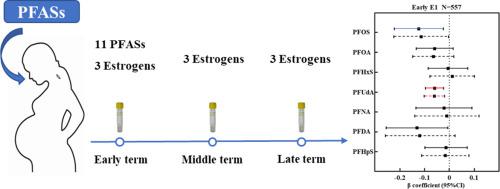Science of the Total Environment ( IF 8.2 ) Pub Date : 2021-09-16 , DOI: 10.1016/j.scitotenv.2021.150360 Jiaqi Yang 1 , Hexing Wang 1 , Hongyi Du 2 , Hongji Fang 1 , Minghui Han 1 , Yuanping Wang 1 , Linji Xu 3 , Shuping Liu 3 , Jianping Yi 3 , Yue Chen 4 , Qingwu Jiang 1 , Gengsheng He 1

|
Previous studies have suggested that perfluoroalkyl substances (PFASs) can act as endocrine disruptors, but few studies have investigated the effects of serum PFASs on estrogen homeostasis during pregnancy. The present study included 557 pregnant women in Tangshan City, North China, and determined 11 serum PFASs in the early term of pregnancy and three typical estrogens (estrone (E1), estradiol (E2) and estriol (E3)) in the early (n = 557), middle (n = 339), and late (n = 286) terms of pregnancy. Sociodemographic factors and diet information were obtained by structured questionnaires. After adjusting for potential confounders, multiple linear regression model demonstrated negative associations of natural logarithmic transformed serum perfluoroundecanoic acid (Ln PFUdA) with Ln E1and Ln E3 in the early term of pregnancy with β coefficients of −0.060 (95% confidence interval (CI): −0.101 to −0.019) and -0.041 (95% CI: −0.070 to −0.011), respectively. Ln perfluorodecanoic acid (PFDA) was negatively associated with averaged E1 in the early and middle (EM) terms of pregnancy with a β coefficient of −0.205 (95% CI: −0.357 to −0.053). Ln perfluorononanoic acid (PFNA) tended to be negatively associated with E2 in the late term of pregnancy with a β coefficient of −0.134 (95% CI: −0.253 to −0.016) although p-value was slightly greater than 0.05 after false discovery rate (FDR) correction. Mixed effect model found that serum PFDA was negatively associated with E1 (β = −0.123, 95% CI: −0.235 to −0.012) during the entire pregnancy. These findings suggested that exposure to PFASs disturbed estrogen homeostasis in pregnant women and the effects varied with the terms of pregnancy.
中文翻译:

暴露于全氟烷基物质与孕妇的雌激素稳态有关
以前的研究表明,全氟烷基物质 (PFAS) 可以作为内分泌干扰物,但很少有研究调查血清 PFAS 对怀孕期间雌激素稳态的影响。本研究纳入华北唐山市 557 名孕妇,测定了 11 种妊娠早期血清 PFAS 和 3 种典型雌激素(雌酮(E 1)、雌二醇(E 2)和雌三醇(E 3))。早 ( n = 557)、中 ( n = 339) 和晚 ( n = 286) 怀孕条款。通过结构化问卷获得社会人口因素和饮食信息。在调整了潜在的混杂因素后,多元线性回归模型显示自然对数转化的血清全氟十一烷酸 (Ln PFUdA) 与妊娠早期的Ln E 1和 Ln E3呈负相关,β 系数为 -0.060(95% 置信区间(CI) ):分别为 -0.101 至 -0.019) 和 -0.041(95% CI:-0.070 至 -0.011)。Ln 全氟癸酸 (PFDA) 与妊娠早期和中期 (EM) 的平均 E1 呈负相关,β 系数为 -0.205(95% CI:-0.357 至 -0.053)。Ln 全氟壬酸 (PFNA) 往往与 E 2呈负相关在妊娠晚期,β 系数为 -0.134(95% CI:-0.253 至 -0.016),尽管在错误发现率 (FDR) 校正后p值略大于 0.05。混合效应模型发现,在整个妊娠期间,血清 PFDA 与 E 1呈负相关(β = -0.123,95% CI:-0.235 至 -0.012)。这些发现表明,暴露于 PFAS 会扰乱孕妇的雌激素稳态,其影响因妊娠期而异。











































 京公网安备 11010802027423号
京公网安备 11010802027423号